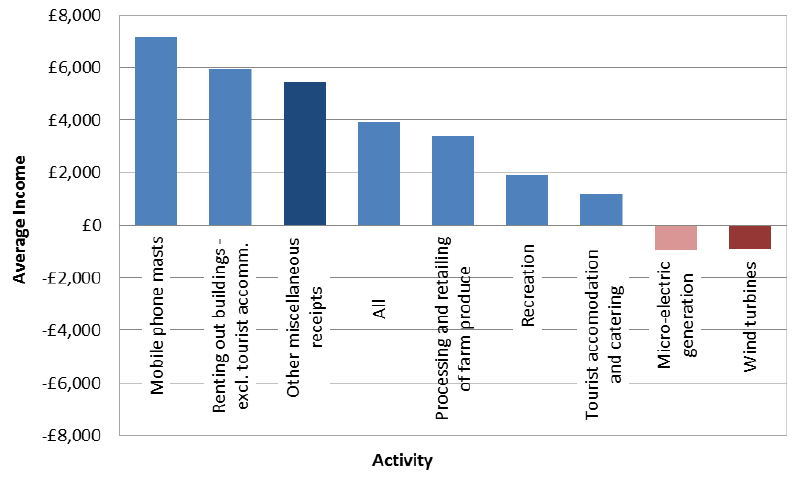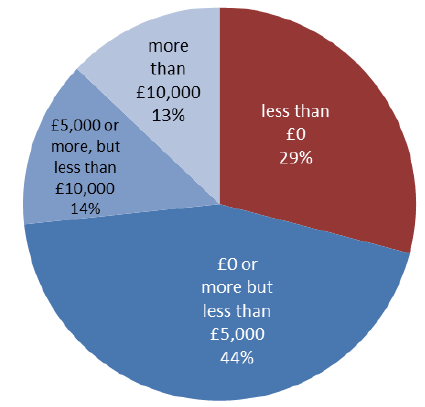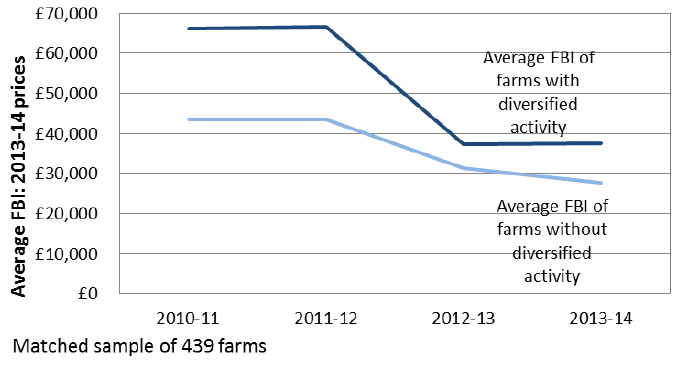Economic Report on Scottish Agriculture 2015
Economic Report on Scottish Agriculture 2015 presenting an overall picture of Scottish agriculture using data from the various agricultural surveys that RESAS manage.
3.9 Income from diversified activity (Tables B1, B5, B6, B7)
Half of all farms in 2013-14 received additional income from diversified activities (non-agricultural activities that use farm resources, e.g. renting out farm cottages for tourism, income from small-medium scale wind turbines, etc.). Chart 3.12 shows the main activities undertaken and the average income from each, taken from Farm Accounts Survey data. Of farms engaged in diversified activity the overall average income from such activities was £4,000. Almost half (43 per cent) of diversified activities were renting out buildings (for uses other than tourist accommodation), but it was income from land used for mobile phone masts that generated the greatest margins from diversification.
Chart 3.12: Average income from diversified activities, 2013-14

Chart 3.13: Distribution of income from diversified activities, 2013-14

Of the other separately identified activities, processing and retailing of farm produce was the least common activity, with only two per cent of farms engaged in this activity.
Micro-electric generation and wind turbines were the only activities which made an average loss, although the losses seen were not as high as in 2012‑13. There are relatively high start-up costs compared to initial output as well as high depreciation costs associated with these activities.
Chart 3.13 shows the distribution of income from diversified activities. Around a third of farms with diversified
activities (29 per cent) did not make a profit from their activities. A further 44 per cent made up to £5,000, with the remaining 27 per cent making more than £5,000.
To examine trends in diversified activities, a matched sample of 439 farms was taken; this sample includes the same farms in each of the last four years, from 2010‑11 to 2013-2014. Over this period the percentage of farms engaged in diversified activities increased from 47 per cent to 50 per cent, though given the sample size it is not clear whether diversified activities are used more frequently now.
The average number of diversified activities on farms with any such activity has remained largely unchanged, at 1.4, as has the share of overall FBI coming from diversified activities, at 16 per cent. Chart 3.14 shows, from the matched sample, the average FBI of those farms engaged in any diversified activity and those with no diversified activities.
Average FBI for farms engaged in diversified activities, at £38,000 is greater than for those without diversified activities (£28,000), but in the last couple of years the size of this difference has decreased. Cereal and general cropping farms had the highest average incomes from diversified activities (Table B1), at around £7,000 and £6,000 respectively per farm.
Chart 3.14: Comparison of average income of farms with and without diversified activities, 2010-11 to 2013-14

The TIFF estimate for the total income from non-agricultural activities was £209 million in 2013 and £227 million in 2014, with costs estimated as £57 million in 2013 and £58 million in 2014.
Contact
Email: Agricultural Statistics
There is a problem
Thanks for your feedback